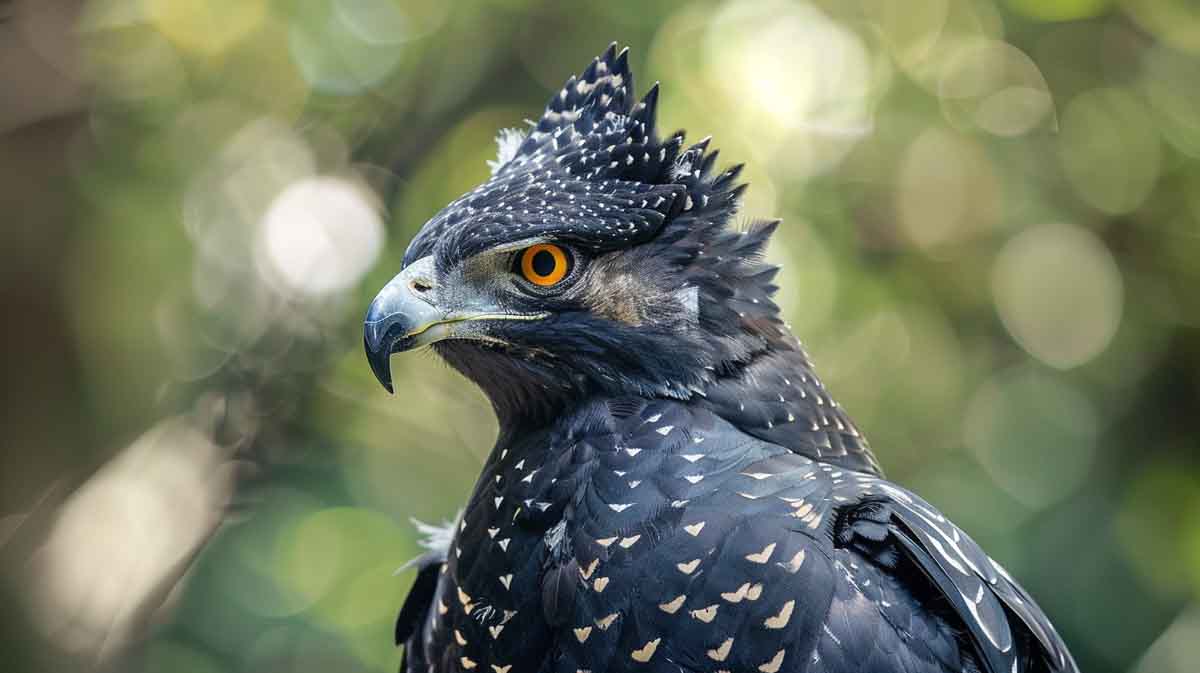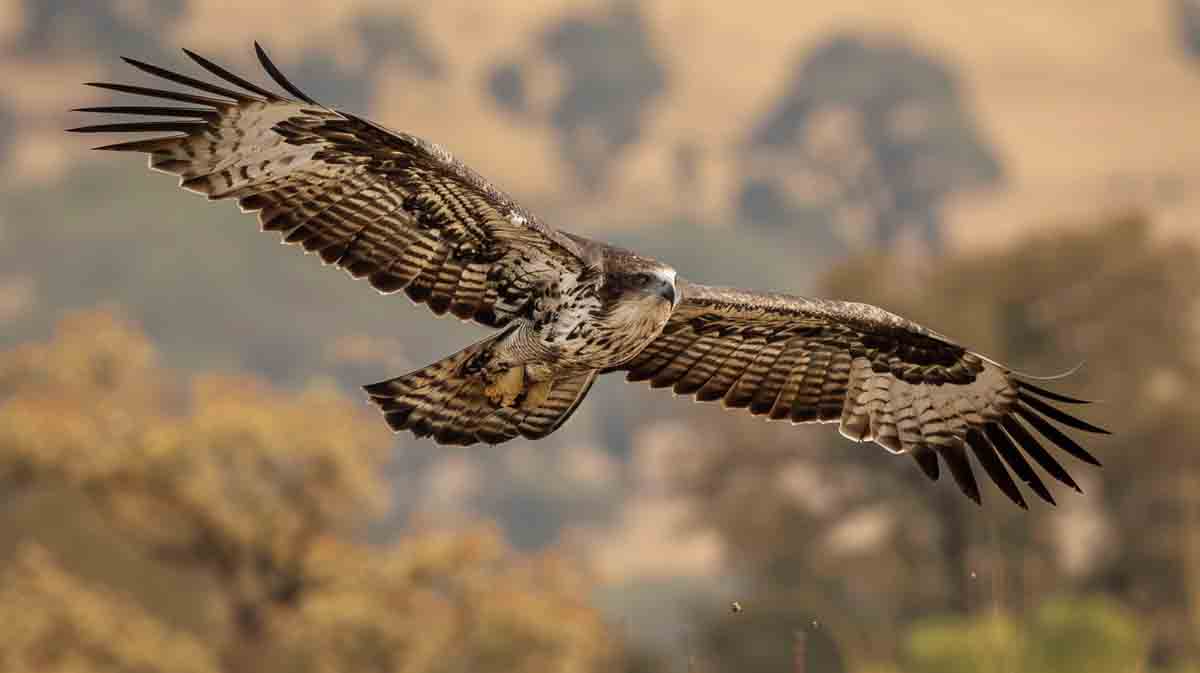Did you know that the African crowned eagle, Stephanoaetus Coronatus, possesses one of the most potent grips of any bird of prey? This magnificent raptor is a formidable predator with a solid force to crush a human skull.
This article will delve into the various aspects of the African crowned eagle’s life, including its habits, habitat, diet, life cycle, and strength. Join us as we uncover this awe-inspiring bird’s unique characteristics and remarkable abilities.
Key Takeaways:
- The African crowned eagle, Stephanoaetus Coronatus, is known for its powerful grip.
- This raptor is one of Africa’s most formidable predators.
- Throughout this article, we will explore the various aspects of the African crowned eagle’s life.
- Topics include its habits, habitat, diet, life cycle, and strength.
- Join us as we uncover this magnificent bird’s unique characteristics and remarkable abilities.
What is a crowned eagle?
This section will overview the crowned eagle, discussing its defining characteristics, distinguishing features, and place in the raptor genus Stephanoaetus Coronatus. We will also compare the crowned eagle to other eagle species, such as the Chaco eagle, and explore the unique characteristics that set it apart from other birds of prey.

Defining the crowned eagle
The crowned eagle, scientifically known as Stephanoaetus Coronatus, is a majestic bird of prey inhabiting sub-Saharan Africa’s forests. This eagle is a sight to behold with its distinctive appearance and powerful presence.
Distinguishing features of the crowned hawk-eagle
The crowned eagle possesses several distinguishing features that make it easily recognizable. These include:
- A large size, with females reaching up to 3 feet long and weighing up to 14 pounds.
- A crowned appearance, with a crest of feathers on its head that gives the eagle its name.
- Powerful, curved beaks and sharp talons enable it to capture and handle its prey effectively.
- A long, broad tail that aids in manoeuvrability and balance during flight.
Understanding the raptor genus: Stephanoaetus Coronatus
The crowned eagle belongs to the raptor genus Stephanoaetus Coronatus, characterized by large, powerful birds of prey well-adapted to their forested habitats. The crowned eagle is one of two species in this genus, the other being the lesser-known but equally fascinating Malagasy crowned eagle (Stephanoaetus mahery).
Comparing eagle species: Eagle Vs Chaco Eagle
One notable comparison comparing the crowned eagle to other eagle species is with the Chaco eagle (Buteogallus coronatus). Although both birds share a similar scientific name, they belong to different genera and have distinct characteristics. The table below highlights the contrasting features of the crowned eagle and the Chaco eagle:
| Crowned Eagle | Chaco Eagle |
|---|---|
| Species name | Buteogallus meridionalis |
| Habitat | Forests of sub-Saharan Africa |
| Distinguishing Feature | Crested head |
| Size | Up to 3 feet in length |
| Beak Shape | Curved and powerful |
| Talons | Sharp and formidable |
Unique characteristics of the crowned eagles
The crowned eagles possess a range of unique characteristics that differentiate them from other birds of prey. These include:
- Exceptional strength: The crowned eagle is renowned for its incredible power and strength, which allows it to catch and handle prey that may outweigh it.
- Intelligent hunting techniques: These eagles are known for their strategic approach to hunting, using their keen senses to track and ambush their prey.
- Parental care: Crowned eagles exhibit remarkable parental care, with male and female eagles actively raising their young.
- Impressive vocalizations: These eagles have a range of vocalizations, including loud, piercing calls that can be heard over long distances.
Where does the crowned eagle reside?
Exploring the habitat of the African crowned eagle
Geographical distribution of the crowned eagle in Southern Africa
Crowned eagles in woodlands
Distribution and habitat change
How is the crowned eagle adapting to its habitat?
This section focuses on the habitat of the African crowned eagle, including its geographical distribution in Southern Africa. These majestic birds primarily reside in woodlands, utilizing these habitats for hunting and nesting.
The crowned eagle’s geographical distribution in Southern Africa is widespread, with populations observed in South Africa, Zimbabwe, and Mozambique. Depending on the available habitats, the crowned eagle can be found in various regions within these countries.
Woodlands are the preferred habitat for crowned eagles. These forests provide cover and a suitable environment for hunting their prey, including small and medium-sized mammals and certain bird species.
However, crowned eagles face challenges due to habitat changes caused by deforestation, urbanization, and other human activities. These alterations to their natural habitat can disrupt their hunting grounds and nesting sites, affecting their survival.
To adapt to these changes, crowned eagles have exhibited remarkable resilience. They have been observed to adjust their hunting techniques and prey preferences based on the availability of resources. Additionally, they have shown adaptability in selecting alternative nesting sites, such as artificial structures like power pylons and tall trees in urban areas.
Threats to the Crowned Eagle’s HabitatAdaptations of the Crowned Eagle
- Deforestation
- Urbanization
- Habitat fragmentation
- Adjustment of hunting techniques
- Shift in prey preferences.
- Selection of alternative nesting sites
The table above summarizes the threats and adaptations of the crowned eagle in response to habitat changes. It highlights these birds’ challenges and ability to adjust and survive in an ever-changing environment.

What does a crowned eagle eat?
The African crowned eagle’s diverse prey selection showcases its versatility as a hunter. Let’s explore the different types of prey this magnificent bird consumes and delve into the fascinating details of its diet.
The prey of the African crowned eagle
The crowned eagle mainly feeds on small to medium-sized mammals, birds, and reptiles. Some of its favoured prey include:
- Monkeys and baboons
- Duikers (small antelopes)
- Giant forest hogs
- Fruit bats
- Guineafowls
- Monitor lizards
- Snakes
This diverse range of prey indicates the crowned eagle’s ability to adapt its hunting strategies to different environments and habitats.
Diet of the crowned eagle: Enough for a hawk eagle?
As a member of the hawk-eagle family, the crowned eagle’s diet plays a vital role in maintaining its energy levels and physical prowess. While smaller raptors, such as hawks, primarily feed on small rodents and birds, the crowned eagle’s large size allows it to prey on larger animals. However, some researchers question whether the diet of the crowned eagle provides enough sustenance to justify its classification as a hawk-eagle.
Prey capture and handling: The power of large talons
The crowned eagle’s impressive talons are crucial for capturing and subduing its prey. Its large, razor-sharp talons are among the strongest of any raptor, capable of penetrating the thick hides of mammals and exerting immense pressure. With its powerful grip, the crowned eagle can immobilize its prey and prevent it from escaping, providing a significant advantage during the capture and handling.
Consequences of livestock as prey
While the crowned eagle primarily targets wild prey, it is also known to prey upon livestock such as lambs and miniature goats. This behaviour has led to conflicts with local communities, as farmers may suffer financial losses due to eagle predation. Efforts are being made to find sustainable solutions that minimize the impact of these conflicts.
Crowned eagles Vs Harpy eagles: A comparison in prey selection
Interest differences emerge when comparing the prey selection of crowned eagles to that of Harpy eagles, another majestic bird of prey. While crowned eagles primarily focus on mammals and reptiles, Harpy eagles have been known to target larger prey, including sloths and monkeys.

Both eagle species have adapted to their respective habitats and developed specialized hunting techniques to capture and subdue their prey effectively.
| Crowned Eagles | Harpy Eagles |
|---|---|
| Mammals: Monkeys, duikers, giant forest hogs | Mammals: Sloths, monkeys |
| Birds: Guineafowls, fruit bats | Birds: Toucans, macaws |
| Reptiles: Monitor lizards, snakes | Reptiles: Snakes |
As the table illustrates, crowned and Harpy eagles exhibit variations in prey selection, reflecting their unique adaptations and ecological niches.
Understanding the life cycle of the crowned eagle
In this section, we will delve into the life cycle of the African crowned eagle, starting with its development from a juvenile to an adult. We will discuss the nesting habits of these eagles, their early days and challenges as juveniles, and the breeding season. Additionally, we will explore the wingspan and growth of crowned eagles throughout their life cycle.
How mighty is the African crowned eagle?
The African crowned eagle is renowned for its impressive power and strength, but is it truly the most powerful eagle in Africa? Let’s delve into the evidence and find out.
Justifying the “most powerful” title: The crowned eagle’s talons
One critical factor contributing to the African crowned eagle’s reputation for power is its extraordinary talons. These formidable weapons can exert incredible force, allowing the eagle to snatch and secure prey with remarkable precision. With talons that can grow up to 5 inches long, the crowned eagle has an undeniable advantage in hunting and overpowering its prey.
The crowned eagle Vs the Martial eagle
While the African crowned eagle possesses impressive power, it faces stiff competition from other avian predators, such as the martial eagle. Both these magnificent birds have exceptional strength, but the martial eagle is the most giant and potent African eagle. With its impressive size and formidable talons, the martial eagle surpasses the crowned eagle in raw power and hunting prowess.

The crowned eagle and human child: A threat?
There have been anecdotal accounts and reports of crowned eagles attacking human children, sparking fears and concerns among communities. However, it is essential to note that such incidents are infrequent. The African crowned eagle typically preys on small to medium-sized mammals and birds, and there is no substantial evidence to suggest that it poses a significant threat to human safety.
Strength of the crowned eagle: Legend or fact?
The African crowned eagle possesses remarkable strength, particularly in its talons. However, claims of it being Africa’s “most powerful” eagle may be more of a legend than a verifiable fact. While it is undoubtedly a formidable predator within its habitat, other eagle species, such as the Martial eagle, surpass the crowned eagle in size and power.
FAQ
What is the distribution and habitat of the African Crowned Eagle?
The African Crowned Eagle, also known as the African Crowned Hawk Eagle, is a large bird of prey found predominantly in sub-Saharan Africa. Its habitat ranges from the rainforests of West and Central Africa to the woodlands and savannas of the south. The eagle is also known to live and breed in parts of Southern African regions such as South Africa and Zimbabwe.
How large is the wingspan of an African Crowned Eagle?
A fully grown adult crowned eagle has an average wingspan of 1.5 to 1.8 meters. This wingspan, along with its vast talons and strong legs, makes it one of the strongest eagles in the world.
Why is the African Crowned Eagle considered powerful?
The African Crowned Eagle is considered Africa’s most potent eagle mainly because of its hunting prowess and physical characteristics. With large talons and strong legs, this eagle, including small antelopes, can take down prey much more significantly than itself.
What do we know about a young crowned eagle?
A juvenile crowned eagle is lighter in colour than an adult, with a noticeable crest and a slightly smaller wingspan. It is cared for by its parents, who bring food to the nest every 3 to 5 days until it can fly and hunt independently.
How does the long tail of the African Crowned Eagle benefit it?
Although the crowned eagle’s long tail imparts it with its unique appearance, it also provides a functional benefit. The long tail helps the eagle’s in-flight manoeuvrability, which is crucial during hunting.
How do the crowned eagles compare to other birds of the world?
Crowned eagles are known for their power and agility, ranking them among the most formidable birds in the world. They’re even considered more potent than the bald eagle, recognized as one of the top predators in the bird kingdom.
Can you tell me more about the female crowned eagle?
Like many birds of prey, the female crowned eagle is typically larger than the male. Besides bringing food to the young, the female crowned eagle plays the principal role in incubating eggs and caring for the young eagle once they hatch.
How often does the crowned eagle pair breed?
A crowned eagle pair tends to breed once every 3 to 5 days. Both parents participate in nest construction and care for the offspring, displaying a high degree of parental investment.
Do crowned eagles live in captivity?
Yes, crowned eagles may be kept in captivity at various locations worldwide. For example, several are housed at the San Diego Zoo in the United States.
Are there any known subspecies of the African Crowned Eagle?
There are no well-recognized subspecies of the African Crested Eagle. That being said, considerable variation in size and colour has been reported across its wide distribution range. The crested eagle is often misidentified as a relative, but it is a separate species.
